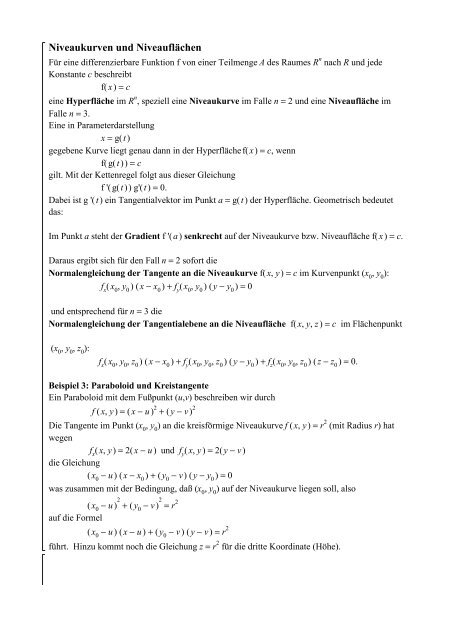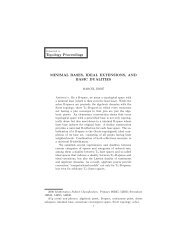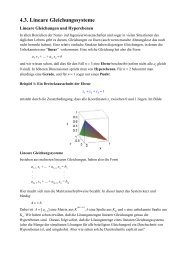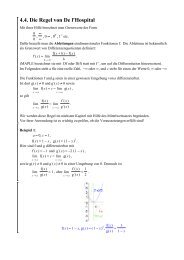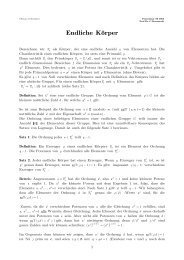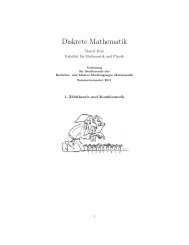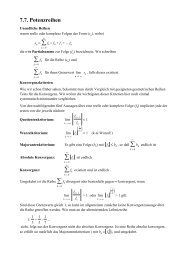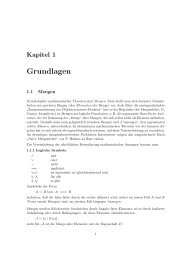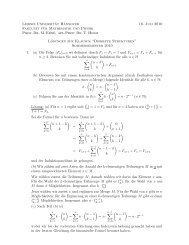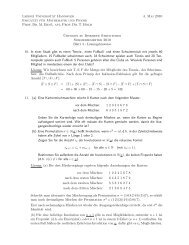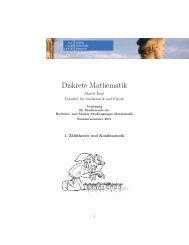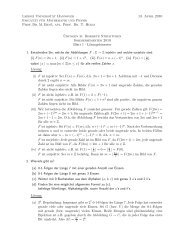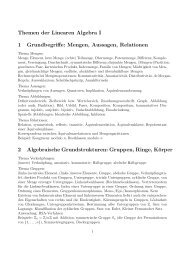5.3A. Gradient und Niveau
5.3A. Gradient und Niveau
5.3A. Gradient und Niveau
Erfolgreiche ePaper selbst erstellen
Machen Sie aus Ihren PDF Publikationen ein blätterbares Flipbook mit unserer einzigartigen Google optimierten e-Paper Software.
<strong>Niveau</strong>kurven <strong>und</strong> <strong>Niveau</strong>flächen<br />
Für eine differenzierbare Funktion f von einer Teilmenge A des Raumes R n nach R <strong>und</strong> jede<br />
Konstante c beschreibt<br />
f( x) = c<br />
eine Hyperfläche im R n , speziell eine <strong>Niveau</strong>kurve im Falle n = 2 <strong>und</strong> eine <strong>Niveau</strong>fläche im<br />
Falle n = 3.<br />
Eine in Parameterdarstellung<br />
x = g( t )<br />
gegebene Kurve liegt genau dann in der Hyperfläche f( x) = c, wenn<br />
f ( g( t ) ) = c<br />
gilt. Mit der Kettenregel folgt aus dieser Gleichung<br />
f ' ( g( t ) ) g'( t ) = 0.<br />
Dabei ist g '( t ) ein Tangentialvektor im Punkt a = g( t ) der Hyperfläche. Geometrisch bedeutet<br />
das:<br />
Im Punkt a steht der <strong>Gradient</strong> f '( a ) senkrecht auf der <strong>Niveau</strong>kurve bzw. <strong>Niveau</strong>fläche f( x ) = c.<br />
Daraus ergibt sich für den Fall n = 2 sofort die<br />
Normalengleichung der Tangente an die <strong>Niveau</strong>kurve f ( x, y) = c im Kurvenpunkt ( x0, y0 ):<br />
f x<br />
( x0, y0 ) ( x − x0 ) + ( x0, y0 ) ( y − y0 ) = 0<br />
f y<br />
<strong>und</strong> entsprechend für n = 3 die<br />
Normalengleichung der Tangentialebene an die <strong>Niveau</strong>fläche f ( x, y, z ) = c im Flächenpunkt<br />
( x0, y0, z0 ):<br />
fx ( x0, y0, z0 ) ( x − x0 ) + fy ( x0, y0, z0 ) ( y − y0 ) + fz ( x0, y0, z0 ) ( z − z0 ) = 0.<br />
Beispiel 3: Paraboloid <strong>und</strong> Kreistangente<br />
Ein Paraboloid mit dem Fußpunkt (u,v) beschreiben wir durch<br />
f ( x, y ) = ( x − u ) +<br />
2<br />
( y − v) 2<br />
Die Tangente im Punkt ( x0, y0 ) an die kreisförmige <strong>Niveau</strong>kurve f ( x, y) = r 2 (mit Radius r) hat<br />
wegen<br />
fx ( x, y ) = 2 ( x − u ) <strong>und</strong> fy ( x, y ) = 2 ( y − v )<br />
die Gleichung<br />
( x0 − u ) ( x − x0 ) + ( y0 − v ) ( y − y0 ) = 0<br />
was zusammen mit der Bedingung, daß ( x0, y0 ) auf der <strong>Niveau</strong>kurve liegen soll, also<br />
( x0 − )<br />
auf die Formel<br />
u 2<br />
+ ( − )<br />
y 0<br />
v 2<br />
( x0 − u ) ( x − u ) + ( y0 − v ) ( y − v ) = r 2<br />
=<br />
r 2<br />
führt. Hinzu kommt noch die Gleichung z = r 2 für die dritte Koordinate (Höhe).


